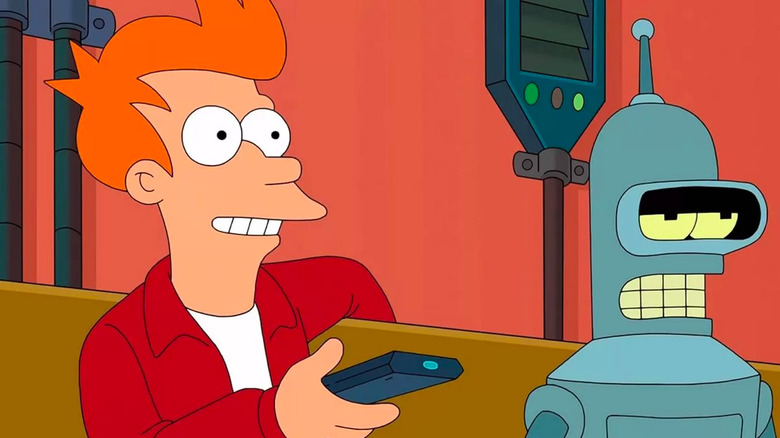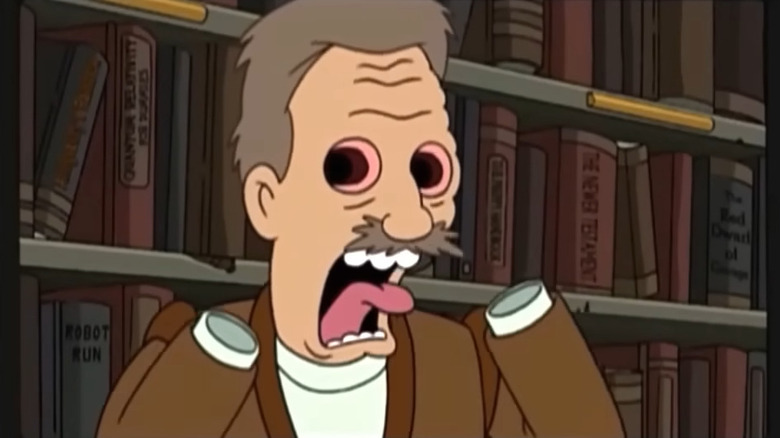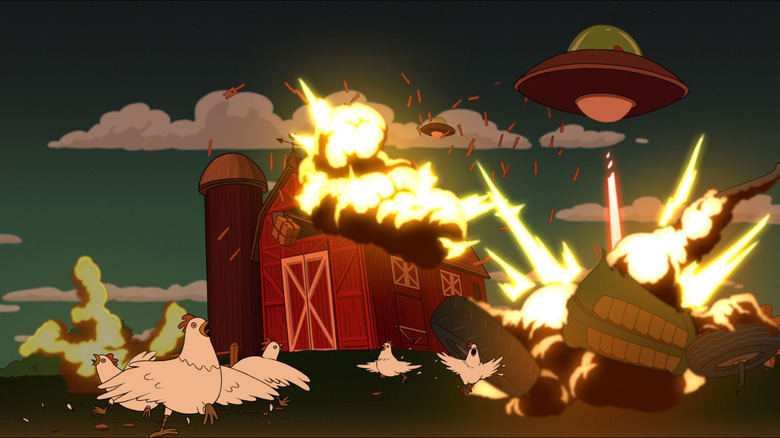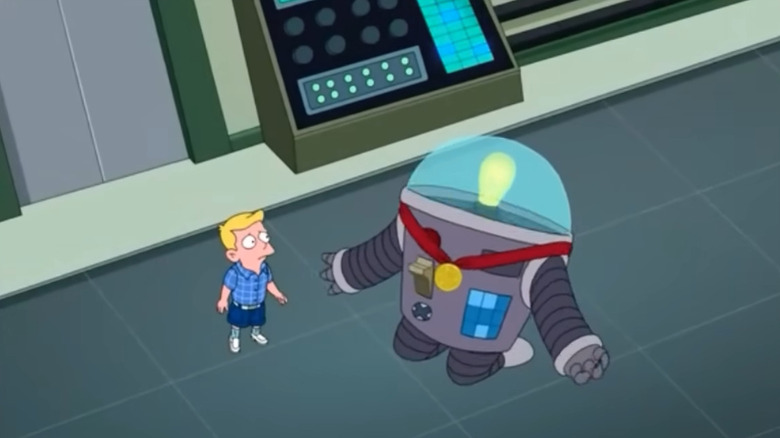Futurama's The Scary Door Parodies An Apocalyptic Twilight Zone Episode
Periodically throughout the animated sci-fi sitcom "Futurama," the couch potato characters will sit in front of their 31st-century TV and take in an episode of "The Scary Door." "The Scary Door" is the future's take on "The Twilight Zone," complete with a Rod Serling-like announcer (played by Maurice LaMarche) explaining the weird ironies about to be witnessed. Naturally, the twist endings in "The Scary Door" go beyond irony and dive headfirst into absurdity.
In one episode, a gambler dies and awakens in an afterlife casino. He wins once and figures it must be Heaven. He wins twice and figures that it must be Hell; what gambler wants to win every time? But then he realizes that his afterlife casino is actually on a plane ... and there's a monster on the wing of the plane. When he calls someone for help, he realizes that he is also Adolf Hitler. He turns to Eva Braun sitting in the seat next to him. She removes her human mask and is actually a giant fly.
Really makes you think.
The "dead gambler who always wins in the afterlife" scenario is taken from a "The Twilight Zone" episode called "A Nice Place to Visit" (April 15, 1950) wherein a dead gangster (Larry Blyden) gets whatever he wants, eventually realizing that's what Hell is. The "monster on the wing of the plane" bit is, of course, from "Nightmare at 20,000 Feet" (October 11, 1963), the episode wherein William Shatner sees a gremlin on the wing of his airliner. The "you're Hitler" twist comes from "The Man in the Bottle" (October 7, 1960), wherein Luther Adler asks a genie to make him a powerful politician, and is transformed into Hitler. The "Eva Braun is the Fly" bit was just a joke.
Time Enough at Last
And that was just one episode of "The Scary Door," as it was seen in "I Dated a Robot" (May 13, 2001). There were six "Scary Door" segments throughout "Futurama," each one of them spoofing a specific episode of "The Twilight Zone," or some other notable sci-fi classic.
All casual viewers may be familiar with the "Twilight Zone" episode called "Time Enough at Last" (November 20, 1959). In it, Burgess Meredith plays a bookish, glasses-wearing loner who prefers the company of books over people. While reading in a bank vault one day, the atomic bombs drop, wiping out all of humanity. Meredith emerges from the bomb-proof bank vault, finding that the local library survived the blast. He is ecstatic at the solitude and begins planning his reading list for the next several decades. Time, he says. There's time enough at last. Then his glasses slip off of his face and break on the ground. He can no longer read. "That's not fair," he says.
In the "Scary Door" version of the episode — featured in "A Head at the Polls" (December 12, 1999) — the setup is the same: bookworm survives the apocalypse and moves into a library. When his glasses break, though, he points out that his eyesight isn't that bad and that he can read large-print books. Then his eyeballs fall out. Without panicking, he points out that he can also read Braille. Then his hands fall off. Only then does he scream. Then his tongue falls out. Then, for good measure, his head also falls off.
As Bender (John DiMaggio) watches the episode, he is chilled by the protagonist's hubris.
This might be the best "Scary Door" episode.
Other references besides
In "Benderama" (June 23, 2011), there is a spoof of the "Twilight Zone" episode "The Brain Center at Whipple's" (May 15, 1964). In that episode, Mr. Whipple (Richard Deacon) begins replacing the workers in his factory with robots, thinking it will increase efficiency. It does. He replaces the secretary pool as well, and business booms. Whipple soon finds that he's lonely, missing human contact. Naturally, he too is eventually replaced by a robot (Robby the Robot).
In the "Scary Door" spoof, the scientist builds a robot to help him at work. Then he asks the robot to look after his wife and kids. He soon realizes that his wife and children prefer the robot over him. So far, so Serling. In a final gag, though, the scientist then orders the robot feel his tragic irony for him. The robot falls to its knees and screams "Noooooo!" The scientist enjoys a drink.
The "Scary Door" episode seen in the "Futurama" movie "Bender's Game" isn't a spoof of a "Twilight Zone" episode, but of H.G. Wells' "War of the Worlds." In Wells' classic, a host of seemingly indestructible invading aliens nearly destroy the Earth. Human weapons are useless. The aliens, however, all eventually die out, as they were unprepared for human viruses, something we didn't even think to employ.
In "The Scary Door," invincible aliens are likewise attacking, and human weapons are no match. Then the saucers begin crashing. The Serling-like announcer points out that weapons are useless, but aliens can be defeated by God's most humble animal: the tyrannosaurus Rex. There is then a wonderful glory shot of a dinosaur bating UFOs from the sky.
The non-references
Of course, the writers of "Futurama" often just stuck with the spirit of "The Twilight Zone," rather than spoofing it outright. There is a "Scary Door" episode, for instance — seen in "Lrrreconcilable Ndndifferences" (August 26, 2010) — wherein a vagrant is heckling a politician about the fact that aliens may already be among us. The politician yanks off the vagrant's face, revealing that he was, in fact, the alien all along. This doesn't synch up with any "Twilight Zone" story, but feels like something Rod Serling might have written.
In "Spanish Fry" (July 13, 2003), the episode must have been running long, as the "Scary Door" sequence was reserved for the episode's credits sequence. Underneath the many names of Rough Draft's animation team, viewers could see a mad scientist busily mixing the DNA of the most evil creatures on Earth; mostly predators and animals with pointy teeth. He dumps his DNA slurry into a cloning chamber, hoping to create the most evil animal in the universe. The chamber opens up and a naked white guy steps out. "It turns out it's man," he says flatly.
While the "Spanish Fry" "Scary Door" episode isn't referring to any one Serling script, it does show the bold efficiency of Serling's storytelling. What "The Twilight Zone" needed to do in 30 minutes, "The Scary Door" did in 30 seconds.
Naturally "The Scary Door" is a loving satire, poking fun at the way "The Twilight Zone" was written, but adding a gag to it; show creators David X. Cohen and Matt Groening aren't trying to point out the weaknesses in what might be the most influential sci-fi series of all time. They're just giving it a big hug.



